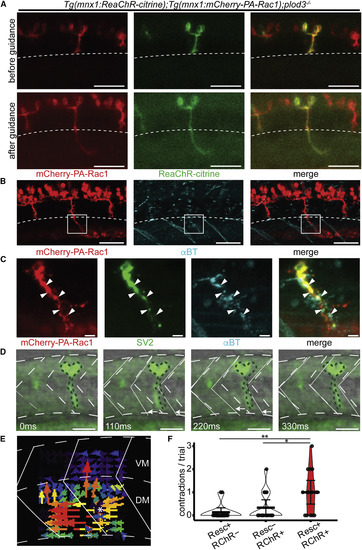Fig. 5
- ID
- ZDB-FIG-200709-51
- Publication
- Harris et al., 2020 - Long-Range Optogenetic Control of Axon Guidance Overcomes Developmental Boundaries and Defects
- Other Figures
- All Figure Page
- Back to All Figure Page
|
Functional Restoration of Synaptic Connectivity with Ventral Myotome Following Rescue of plod3−/− Zebrafish CaP Axons (A) Before (top) and after (bottom) PA-Rac1 optogenetic-mediated rescue of plod3−/− mutant zebrafish expressing both mCherry-PA-Rac1 (red, left) and ReaChR-citrine (green, middle) transgenes (merge right, scale bar, 50 μm). Only the rescued axon extends into the dorsal myotome, past the horizontal myoseptum (dashed white line). See also Video S5. (B) Immunohistochemistry for mCherry (red, left) and αBT (cyan, middle) illustrates that only the rescued axon extends past the horizontal myoseptum (merge, right; scale bar, 50 μm). Note that red-channel fluorescence ventral to the indicated region of interest (ROI) is from nonspecific accumulation of secondary antibody in the yolk sac. (C) Immunohistochemistry for mCherry (red, left), SV2 (green, middle left), and αBT (cyan, middle right), showed significant colocalization of pre- and post-synaptic markers (merge, right; n = 3 fish, Costes p value > 0.95) in the ventral myotome of the stimulated axon (solid white box in B; scale bar, 5 μm). (D) Time series of ventral myofibril contractions following ReaChR stimulation of a rescued CaP axon. The dotted green lines show the initial position of the axon. The white arrows show the movement of the somatic boundaries (white lines) in the ventral, but not dorsal, myotome compared with time 0 (gray dashed lines; scale bar, 50 μm) (E) Vector fields representing the motion of the zebrafish body wall following ReaChR stimulation of a rescued CaP axon, computed via particle image velocimetry using optical flow analysis of bright field time series images. Color-coded arrows represent the direction and magnitude of optical flow; the point of vector field convergence indicates the initial focus of contraction and is marked by a white asterisk. For the majority of elicited motor responses, the contraction occurred specifically in the somite innervated by the rescued axon (15/17 contractions, see also Videos S6 and S7). (F) Optogenetic depolarization of rescued plod3−/− axons via activation of ReaChR channelrhodopsin (Resc+ RChR+) resulted in significantly more contractions of ventral myofibrils in the targeted somite compared with ReaChR activation of a neighboring axon that had not been rescued (Resc− RChR+) or illumination of the rescued axon stimulated with wavelengths of light outside of the ReaChR activation spectrum (Resc+ RChR−). (Pairwise comparison of estimated marginal means from a Poisson general linear model, n = 3 fish, 5 trials per condition, ∗p < 0.05, ∗∗p < 0.01, mean and 95% CIs shown; see also Video S6). |
Reprinted from Developmental Cell, 53, Harris, J.M., Wang, A.Y., Boulanger-Weill, J., Santoriello, C., Foianini, S., Lichtman, J.W., Zon, L.I., Arlotta, P., Long-Range Optogenetic Control of Axon Guidance Overcomes Developmental Boundaries and Defects, 577-588.e7, Copyright (2020) with permission from Elsevier. Full text @ Dev. Cell

